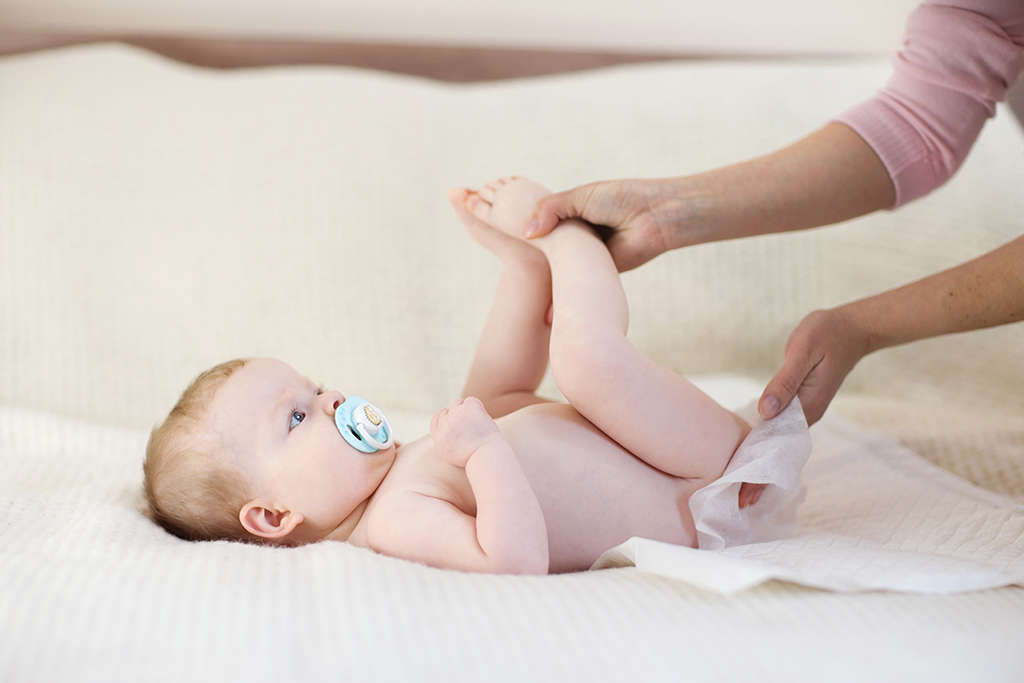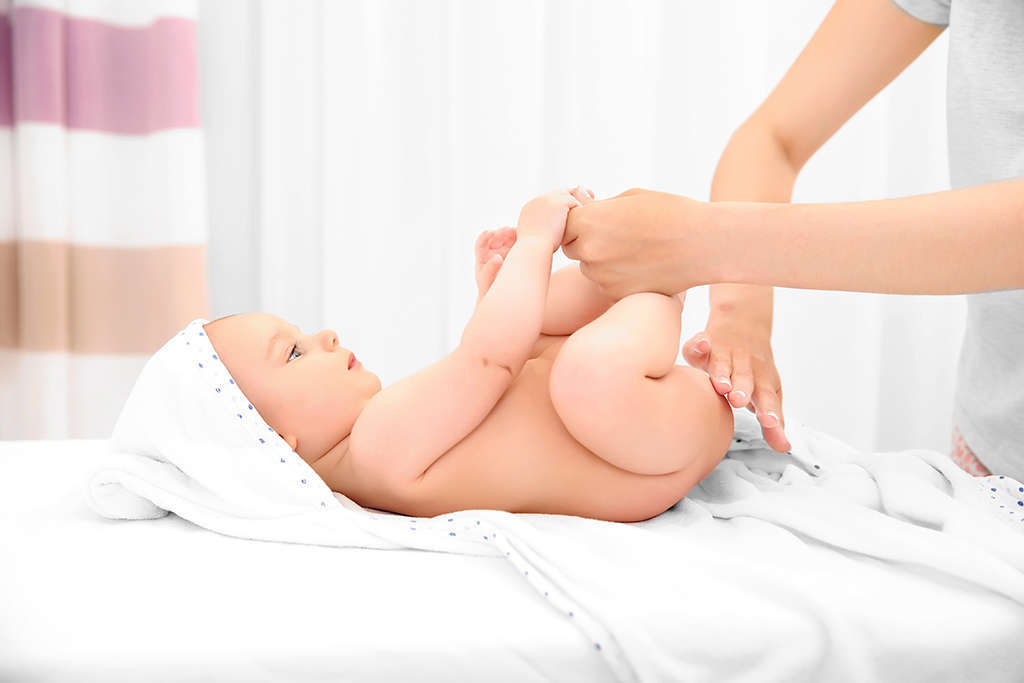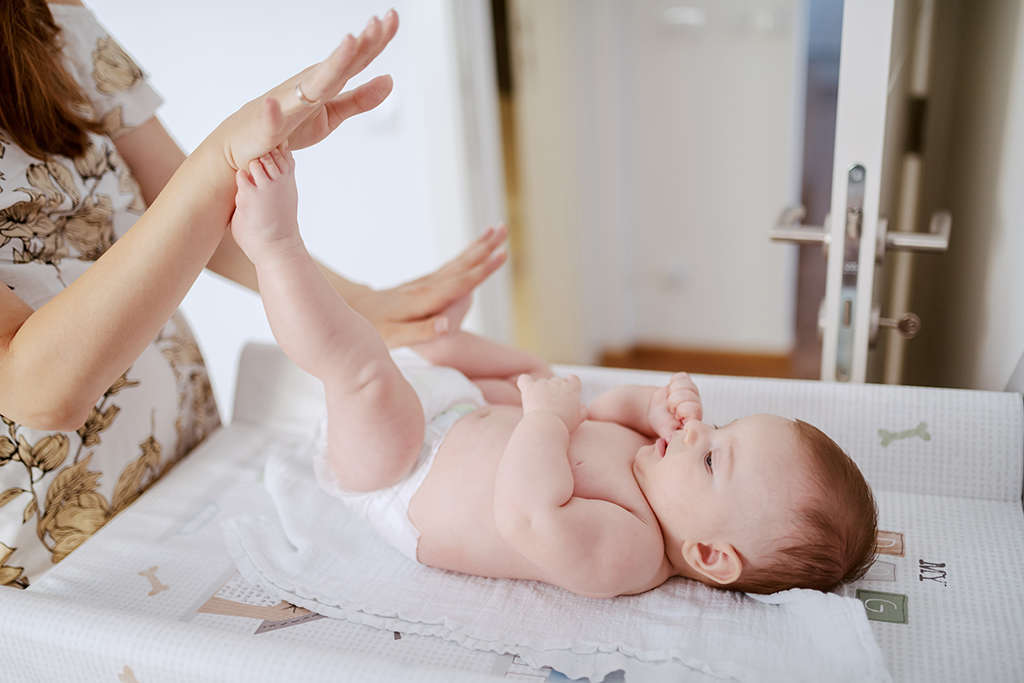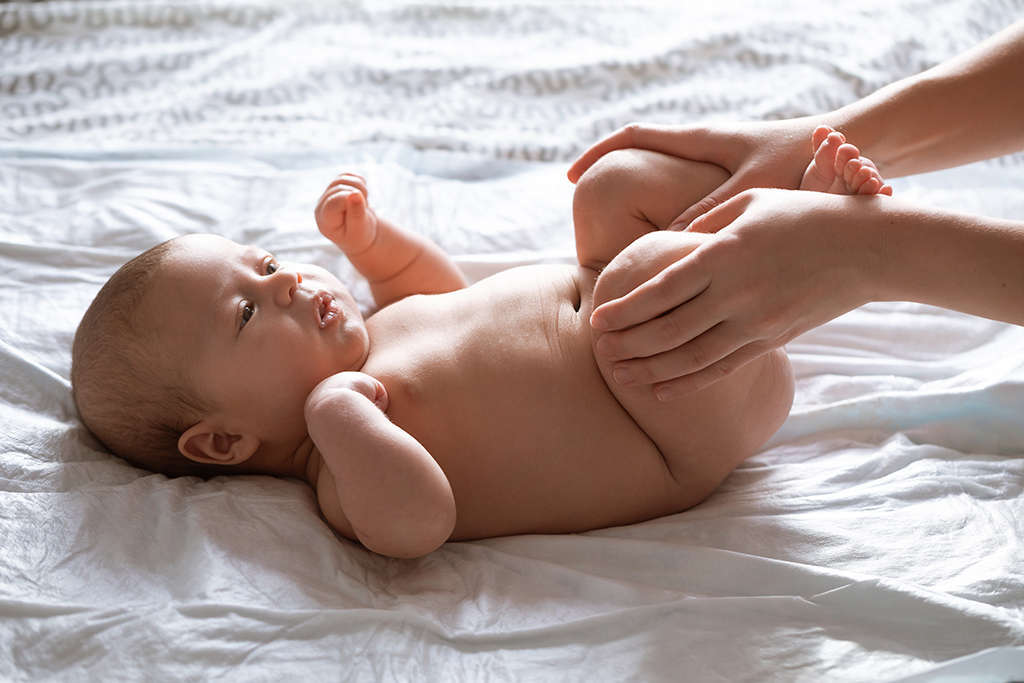Is your toddler diaper changing routine filled with drama and resistance? Are you looking for a handy diaper-changing how-to guide to win the battle? This detailed guide will take you through all you need to establish a hassle-free diaper change routine, including effective tips, step-by-step information on how to hold baby’s legs when changing diaper, FAQs and much more.
Baby Fights Diaper Changes? Here’s How To Re-Envision Your Bub’s Diapering Routine
Those new parents who find dealing with soiled infant diapers and occasional poop explosions struggling don’t really know that a toddler diaper changing can be an even bigger struggle. Many toddlers despise diaper changes and will wail, kick, hit, and do anything they can to avoid them.
Others might not really resist but can be too mischievous to handle during the process. At times, they’d twist and turn over and over again, or even arch their backs or attempt to snatch the diaper/wipes from you and explore everything. Or they might be so engrossed in a fun activity they’re doing that they won’t allow you near them, no matter how much they need a change.
Whether you are a new parent dreaded by your friends’ horrendous toddler diaper changing stories or are struggling with this sudden diaper-changing battle, this article will make sure you don’t leave without learning something useful.
How To Keep Baby Still During Diaper Change?
You won’t even realize how quickly those calm diaper-changing routines of your tiny tot transform into struggling bouts of a writhing, kicking and wiggly toddler. Preventing your little munchkin from hurling themselves off the changing table to avoid any messes on the changing pad and ensuring their safety is what makes the overall process so tedious.
Although your toddler will eventually get over their stubborn diaper-changing routine and accept it as a normal part of their daily routine, keeping them still until they decide to cooperate will be a difficult task. Hence, here are a few effective tricks that many parents find helpful to combat the resistant diaper-changing phase:
1. Keep All The Diapering Supplies Ready
First of all, keep all the supplies you need for a diaper change handy and within immediate reach. To avoid being caught off guard, the best way is to organize the diaper-changing table in such a way that you don’t have to rush around for anything and have everything stacked in the same place. Some parents like the convenience of a rolling baby changing table to make their life easier and avoid the hassles of bending over to fetch diapering supplies.
2. Distract Them By Some Music
- Now, place your bub on the changing table or mat and play their favorite rhyme, song or music to distract their mind off the diaper change
- You can also hang a rotating mobile above their changing table so that they are involved in its movements and music
- If this trick seems to work just a few times, try changing the song each time
3. Take The Help Of Their Favorite Toys
If your toddler’s mind is not diverted by any musical distraction anymore, give them something to play with, like rattles, teethers, or small toys.
4. Offer Their Pacifier
If your toddler loves their pacifier, offer it right at the time of their diaper change so that they may get busy with it.
5. Imitate The Diaper Change On Their Favorite Doll First
Keeping the stereotypes aside, all toddlers like playing with dolls, and many of them enjoy it when their parents reciprocate all their routines with their dolls. If your toddler is resistant to having their diaper changed, try replicating it on their doll first so that they will be more eager to have it done on them as well.
6. Play Peekaboo
If your toddler doesn’t keep still on their changing table, play peekaboo with them for a few minutes, concealing their face with a light washcloth and smiling as you reveal it. They’d quickly be distracted with the fun game and wouldn’t battle their diaper change any more.
7. Let Them Explore
Sometimes, your toddler would snatch your diapering supplies to either explore or help you – but you’d consider it as a sign of resistance. If they want to have a diaper in their hand, let them have it so they’ll lay still and make the change easier on both of you.
8. Let Them Help (Not Really)
Or they might have a strong desire to be independent and see everything that’s going on below that they can’t really see when they are lying still on the table. Let them feel they are taking part in the activity, but also consider it a great time to start potty training.
9. Get Ready For Exceptions
Sometimes, even all these tricks won’t seem to do the job if your toddler is determined to stand up during their diaper change. It’s where you have to accept the exception and adjust accordingly.
10. Bring In a Helper
If your toddler has another sibling, diaper changes with an older child may be extremely helpful as they might help hold your squirmy baby’s hands or distract them. You might even call your partner for help, especially if there’s a seriously poopy diaper.

How To Hold Baby’s Legs When Changing Diaper?
Here are a few effective ways to hold your baby’s legs when changing their diapers.
1. Undress Them Partially & Grab Their Legs With One Hand
Nothing grosses parents out more than when their toddlers kick in their poop during a change. So, keeping their little pants around their calves actually helps keep both feet together and makes it easier to hold them with one hand.

2. Let Your Fingers Do The Job
Another easy and effective way to hold your baby’s legs during diaper changes is to lay them on their back in a safe and comfortable position with their legs completely extended and spread slightly apart. Now, hold one of their feet between your ring finger and pinkie finger & grab the other ankle using the space between your index finger and middle finger.

3. Push Their Legs Near Their Face
In cases when there is not much poop to handle, simply hold their legs together with one of your hands, and gently pull them up and push them back near the baby’s face.

4. Hold Their Knees
If you find holding their legs slightly difficult, this is another effective approach you can take. Gently hold their knees to keep their legs in place while pulling them apart for a quick diaper change.

Toddler Diaper Changing: How To Put A Diaper On A Baby?
Once you know how to keep your bub still and hold their legs properly when you lay them on the changing table, here’s how to put on their diaper quickly and easily – without making it feel like a negative experience for them or yourself!
1. Wait For The Right Time
We don’t mean you should wait hours for a diaper change and leave your child in a complete mess. However, the new diaper can wait a few minutes. Most toddlers resist their diaper-changing routine when they are in the middle of something they love doing. So, rather than forcing them to lay still on the changing table, ask them to spare you a few minutes for a small diaper-changing session once they are done.
You’d be surprised to see how cooperative they are without being grumpy or unhappy. After all, kids love it when they are given the authority to decide. If they are taking longer than expected, countdown the minutes and tell them you’ll be changing their diaper shortly so they’re not caught by surprise.
2. Make It Fun
You may not enjoy changing diapers, but by making it fun for your toddler, you may save a lot of time, effort, and struggles, as well as avoid messes. Talk or sing to them or tickle them gently to lift their mood and help them forget they were about to resist the diaper change.
3. Ask Them To Lift Their Body
While you want to distract their mind off the diaper change, you also want to keep them involved. Don’t understand what we mean? Well, you actually want to distract their mind from that stubborn feeling while making them understand they need their diaper to get changed to stay clean.
Hence, once your baby lays still on their changing table without any cries, kicks, or resistance, rather than lifting their legs yourself, ask them to do it. You can either pretend it’s a plane that is taking off or maybe tell them “Tom & Jerry” would go beneath their bum if they quickly lift off.
4. Work As Fast As Possible!
Your bub won’t lay still for a long time, so you’ve got to rush and work really quick to change their diaper. Remove the soiled diaper, wipe your baby off, remove the dirty diaper, slide a new one above their legs or under their bum as per its configuration, adjust for fit, and you’re done!
5. Reward & Kiss Their Belly
Praise and give them a lovely kiss on their belly, followed by a soft tickle to make them happy every time they cooperate well and get their diaper changed easily. Toddlers love it when their parents blow raspberries on their tummies and go to great lengths to earn that reward.
Simple But Genius Diaper Changing Tips To Navigate The Messy Tug Of War Easily!
Here are some of the most tried and tested diaper-changing tips that’ll make your life much easier.
- Routines work for everyone and are even better for toddlers, as they hate changes. Your toddler will quickly outgrow the stubborn diaper-changing phase if you have a consistent routine for it. For example, always change their diaper the first thing after they wake up. This way, they’d quickly feel comfortable with it.
- Always change their diapers in the same place so that they are ready for what’s going to happen.
- While signaling your baby for their diaper change or lifting their body off the table, always use the same words to trigger an automatic behavior.
- Don’t confuse their cooperation to be permanent. Your toddler may be fine with their diaper change one day, but the next, they might start running away, hiding, screaming, and fighting you over diaper changes. Hence, consistency is really important!
- As toddlers become more self-aware, they may sense the need for privacy when getting their diapers changed. It’s critical to recognize their demand, give your toddler the freedom of where they want to get it done and engage them by allowing them to choose whether or not to close the door. Accommodating these demands and offering these choices will help them feel happier and more independent. However, this is also an indication that they are ready for potty training.
Toddler Diaper Changing: Things To Be Aware of & Some Major Reasons For Their Resistance
Here are some more things you need to know about toddler diaper changing and some reasons why they might make their diaper changes so difficult.
- Always wash your hands before changing your baby’s diaper for the sake of sanity, or you can end up giving them an infection.
- Sometimes, toddlers would hate changing because of rashes and a sore bottom. Be extra gentle and apply an effective diaper rash cream that’ll do its magic within hours.
- Keep an eye out for other symptoms including a urinary tract infection (UTI), a fever, or foul-smelling urine, and see your pediatrician about the available treatment options.
- Also, if your baby seems to develop rashes around their leg and waist quite often, change the brand you are currently using as your baby might be sensitive to it.
- Even after the rash has healed, your toddler’s resistance to having their diaper changed may persist due to the recollection of pain it may have caused them. So, let them take a few days to process that they are fine now and their bottom no longer hurts.
- Your little stinker might also resist their changing sessions as they might hate their changing table. If nothing seems to work, try replacing their changing mat first and if they still wail & kick, try changing the entire place. Place their changing pad on the floor and see if they cooperate.
- Some toddlers might have an uncanny knack for fighting over diaper changes if they feel cold and don’t want their clothes to be taken off. Understand their body language, adjust the temperature around them and work as fast as possible.
- Older toddlers may not like the scented diapers or character prints on them. Try getting creative and choose the next pack wisely.
If you are using a rolling baby changing table, be extra cautious of your baby’s safety to ensure it doesn’t collapse or your bub doesn’t fall down.
Frequently Asked Questions About How To Put A Diaper On A Baby
Have some questions related to how to make diaper changes easier on your mind? Here are our answers to some of the most commonly asked questions about toddler diaper changing.
How often should you change a toddler’s diaper?
Ideally, you should change your toddler’s diaper every four to five hours, but the frequency with which you do so is determined by how often they urinate or soil the diaper with poop. Leaving them in a soiled diaper for too long can cause UTIs and painful diaper rashes.
Is it normal for toddlers to hate diaper changes?
If your baby fights diaper changes, they might either have a diaper rash or would hate leaving the activity they were doing. Whatever the reason may be, it is normal for toddlers to hate diaper changes, but this is a small phase that gets over quickly.
Can a 5 year old change a diaper?
Although a five-year-old is large enough to be potty trained, your baby might still need diapers for some unwanted reasons or just for the nighttime. By age 5, they can change their own diaper, but they can’t do it all by themselves. So, don’t leave them completely unattended and offer help whenever required.
How do I know if my toddler needs a diaper change?
Typically, you’ll need to check their diaper every two to three hours to see if they’ve soiled it heavily. If there is poop, you can either smell it and tell right away, or you can discover them standing still, staring off somewhere at the ceiling, or even hiding behind a large piece of furniture to do it with full relaxation and focus.
Understood How To Make Diaper Changes Easier?
Whether you were looking for the ultimate guide on how to keep baby still during diaper change or some effective diaper changing tips, we hope this article helped you become a diapering pro! Changing diapers for a squirming baby who soon grows into a bossy toddler adds to the difficulty. But remember, you’re not alone!
This is only a temporary phase that will fade away soon. Your toddler may suddenly hate getting their diapers changed as they seek independence and control over their bodies – which is actually a great time to empower their personality. Dealing with challenging diaper changes requires a mindful approach to comforting your baby, gaining their trust and learning your baby’s preferences.

